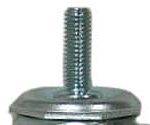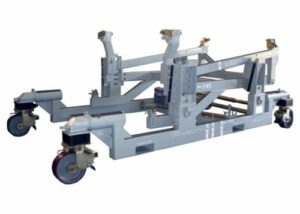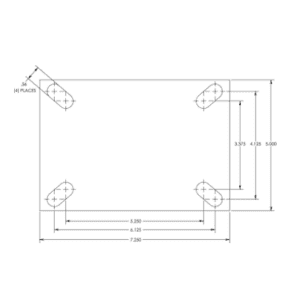When moving heavy loads exceeding 5,000 lbs, choosing the right caster isn’t just about mobility. Safety, efficiency, and durability are also important. Stem casters and plate casters are the most common designs, each with unique advantages. Let’s compare them to find the best option for your material handling needs.
What Are Stem Casters?
 Stem casters feature a cylindrical or threaded stem that inserts directly into the mounting surface. This can be a hollow tube or a pre-installed socket.
Stem casters feature a cylindrical or threaded stem that inserts directly into the mounting surface. This can be a hollow tube or a pre-installed socket.
Advantages of Stem Casters for Heavy Loads:
-
Compact and Space-Saving Design:
- Stem casters are ideal for applications where mounting space is limited, such as narrow or confined frames.
-
Greater Flexibility in Attachment:
- Stem casters are easy to install and fit into tight, preexisting mount points without requiring large mounting plates.
-
Customizable Mounting Options:
- With various stem sizes, threading options, and materials, stem casters offer flexibility for unique setups.
-
Shock Absorption:
- Certain stem casters with spring-loaded designs can absorb impact, making them suitable for rough or uneven surfaces.
-
Lightweight Solutions:
- In some cases, they reduce the overall weight of the cart or equipment while still handling the load.
When Stem Casters Work Best:
- Stem casters work best in applications requiring tighter mounting spaces. They are also a good choice when mobility and flexibility outweigh maximum load stability.
What Are Plate Casters?
 Top Plate Casters are the most common type of caster assembly, providing mobility for a wide variety of material handling applications. One big advantage is the caster mounting plate (top plate) offers more surface area than a stem caster. And that means better weight distribution, allowing a plate caster to handle heavier weight loads than a stem caster. Our plate casters come in a wide variety of options and weight capacities.
Top Plate Casters are the most common type of caster assembly, providing mobility for a wide variety of material handling applications. One big advantage is the caster mounting plate (top plate) offers more surface area than a stem caster. And that means better weight distribution, allowing a plate caster to handle heavier weight loads than a stem caster. Our plate casters come in a wide variety of options and weight capacities.
Caster Concepts only carries plate casters, which are available in kingpin and kingpinless designs, because of their ability to handle heavier loads.
Advantages of Plate Casters for Heavy Loads:
-
Exceptional Load Distribution:
- The wide mounting plate spreads the load across a larger surface area, reducing stress on the mounting point.
-
Higher Weight Capacities:
- Plate casters handle extreme loads with greater stability, making them ideal for loads exceeding 5,000 lbs.
-
Robust and Secure Installation:
- Bolted plates ensure a more secure and durable attachment compared to stem designs.
-
Enhanced Stability for Large Loads:
- The plate’s size and rigidity offer better control and reduced risk of tipping.
-
Customizable Plate Sizes:
- Available in various sizes to match the load base and application requirements.
When Plate Casters Work Best:

Engine Dolly
- Plate casters are excellent in applications involving extremely heavy loads or where stability is critical. Examples include industrial manufacturing or warehouse operations.
- They excel in environments with repetitive and high-impact movements, where durability and reliability are non-negotiable.
Which Should You Choose?
- Choose Stem Casters if:
- Your equipment has a lightweight or modular design with limited mounting space.
- Choose Plate Casters if:
- You’re moving heavy-duty loads that exceed 5,000 lbs and require maximum stability.
- Your equipment operates in demanding industrial environments with frequent, high-impact movements.
Pro Tip: When using plate casters, ensure you have the correct plate size. To determine this, you will want to measure the bolt-hole spacing:

- Measure the center of one bolt to the center of another bolt on each side of the caster.
- Make sure to measure the bolt’s length, width, and diameter.
- Once you have determined this spacing, you should see if these dimensions match a standard top plate design.
- Some of these designs can have slotted holes, and others can have the exact spacing needed.
To Sum It Up:
Both stem and plate casters have their strengths. However, for loads exceeding 5,000 lbs, plate casters are often the go-to solution for stability, durability, and safety.
Contact us today if you’re unsure which caster type is right for your application. Our engineering experts are here to guide you toward the best solution for your heavy-duty material handling needs. Let’s move your business forward with confidence!







